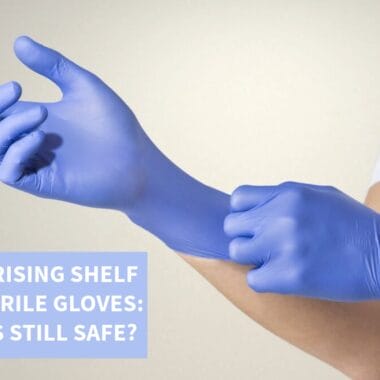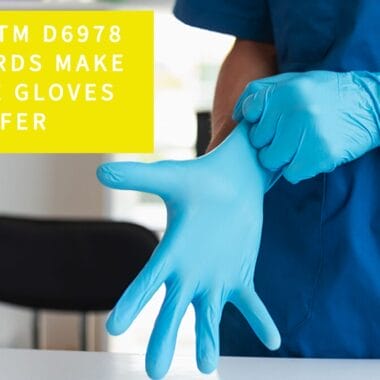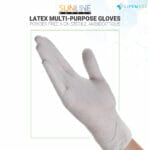What are Non-Sterile Gloves?
Non-sterile gloves are personal protective equipment (PPE) designed to protect the wearer’s hands from contamination and harmful substances during various tasks. While they do not undergo a sterilization process like sterile gloves, non-sterile gloves are widely used in medical examinations, patient care, food handling, and general industrial tasks where protection is needed but sterility is not required. They are crucial in preventing cross-contamination and maintaining hygiene in environments where exposure to germs and chemicals is a concern.
How Do Non-Sterile Gloves Differ from Sterile Gloves?
The primary difference between non-sterile and sterile gloves lies in their production and intended use. Sterile gloves are subject to a strict sterilization process to eliminate all microorganisms and are used for surgical or invasive medical procedures. Non-sterile gloves, on the other hand, do not undergo the same sterilization process and are used for routine tasks where maintaining sterility is not essential, such as medical examinations or cleaning tasks. Both types of gloves provide a barrier against contamination, but non-sterile gloves are generally more accessible and cost-effective.
Types of Non-Sterile Gloves
There are several types of non-sterile gloves, each offering different levels of protection and suited to various applications:
- Latex Gloves: Made from natural rubber, latex gloves offer flexibility, comfort, and protection against contaminants. They are commonly used in healthcare and food service industries. However, some individuals may be allergic to latex, which limits their use in certain settings.
- Nitrile Gloves: Nitrile gloves are made from synthetic rubber and are an excellent alternative to latex gloves for those with latex allergies. They provide strong protection against chemicals, punctures, and infectious materials, making them ideal for medical and industrial use.
- Vinyl Gloves: Vinyl gloves are made from polyvinyl chloride (PVC) and are more affordable than latex or nitrile gloves. While they are less durable and offer lower protection, they are suitable for low-risk tasks such as food handling and light cleaning.
- Polyethylene Gloves: These thin, inexpensive gloves are often used in the food service industry. They offer basic protection and are not suitable for tasks requiring a high level of durability or chemical resistance.
How Do Non-Sterile Gloves Work?
Non-sterile gloves create a barrier between the wearer’s skin and potentially harmful substances, such as germs, chemicals, or contaminants. They are designed to be single-use, ensuring that contamination is minimized during tasks such as medical examinations, patient care, or handling food. Although they are not sterile, non-sterile gloves still protect the wearer and others by preventing the spread of microorganisms or hazardous materials.
Benefits of Non-Sterile Gloves
- Protection from Contamination: Non-sterile gloves are effective in preventing the transfer of germs and contaminants between individuals or surfaces. They help maintain hygiene and reduce the risk of infection in healthcare and food handling environments.
- Cost-Effective: Non-sterile gloves are generally more affordable than sterile gloves, making them a cost-effective option for routine tasks where sterility is not required. This makes them widely accessible in various industries.
- Allergy-Friendly Options: For individuals allergic to latex, non-sterile gloves made from materials such as nitrile or vinyl provide an effective alternative without sacrificing protection.
- Ease of Use: Non-sterile gloves are easy to don and doff, making them convenient for frequent use in fast-paced environments such as hospitals, food service, or janitorial work.
Uses of Non-Sterile Gloves
- Medical Examinations: Non-sterile gloves are commonly used by healthcare professionals during routine exams, blood draws, and patient care activities where sterility is not a requirement but protection against contamination is still necessary.
- Patient Care: Nurses, caregivers, and medical assistants use non-sterile gloves when providing care to patients, such as cleaning wounds, administering medication, or handling bodily fluids.
- Food Handling: In the food service industry, non-sterile gloves help maintain hygiene when preparing or serving food, preventing the spread of bacteria and viruses from hands to food products.
- Industrial and Janitorial Work: Non-sterile gloves are used in industries such as cleaning, automotive, and construction, where they protect workers from exposure to chemicals, oils, and other contaminants.
- Laboratory Work: In laboratories, non-sterile gloves provide protection when handling non-sterile samples, chemicals, or equipment, ensuring that contamination risks are minimized.
Key Features of Non-Sterile Gloves
- Material Composition: Non-sterile gloves are available in various materials such as latex, nitrile, vinyl, and polyethylene, each offering different levels of protection and durability. The choice of material depends on the specific task and the wearer’s sensitivity to allergens.
- Powdered vs. Powder-Free: Some non-sterile gloves are powdered, making them easier to put on and remove. However, powder-free gloves are preferred in medical and food service settings to avoid contamination and reduce the risk of allergic reactions.
- Size and Fit: A proper fit is essential for comfort and performance. Non-sterile gloves come in a range of sizes to ensure that they fit snugly, allowing for dexterity and precision during tasks.
- Thickness: The thickness of non-sterile gloves varies depending on the material and intended use. Thicker gloves offer more protection against chemicals and punctures, while thinner gloves provide better tactile sensitivity for delicate tasks.
Proper Use and Disposal of Non-Sterile Gloves
To ensure the effectiveness of non-sterile gloves, it is important to follow proper donning and doffing procedures:
- Hand Hygiene: Before putting on non-sterile gloves, wash hands thoroughly or use hand sanitizer to minimize the risk of contamination from skin contact.
- Glove Integrity: Inspect gloves for any tears, punctures, or visible damage before use. Damaged gloves should be discarded and replaced immediately.
- Change Gloves Between Tasks: Non-sterile gloves are designed for single-use and should be changed between tasks to prevent cross-contamination. For example, healthcare workers should change gloves between patients, and food handlers should change gloves when switching between tasks.
- Safe Removal: When removing gloves, pull them off by the cuff, turning them inside out to avoid contact with contaminants on the outside surface. Dispose of gloves in a designated waste container and wash hands afterward.
Conclusion
Non-sterile gloves are an essential tool for maintaining hygiene and preventing contamination in a wide range of industries, from healthcare to food service and industrial work. While they do not offer the same level of sterility as surgical gloves, they provide effective protection against germs, chemicals, and other hazards during routine tasks. Proper use, fit, and disposal of non-sterile gloves are critical to ensuring their effectiveness in protecting both the wearer and others from potential contamination.
« Back to Glossary Index

















